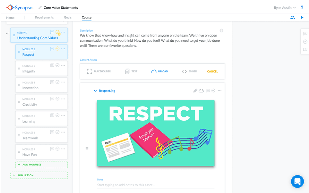One basic assumption in Learning and Development organizations for the last 15 years has been that you need specialized instructional designers using specialized authoring tools to build specialized learning content. What if that assumption is not true? What if the majority of the time you don’t really need specialized content, just an easy way to pull together content you already have or can find internally or externally.
Curation has become a very hot topic in the L&D world. A number of new platforms have been introduced that allow learners to find and organize content into playlists that can be easily shared. The question from L&D professionals remains, “Is it effective?” How do we know it is truly impacting performance?

What if you could quickly take your business requirements, ask your subject matter experts to share relevant content, and then assemble it for delivery to your learners? Would I really need a handcrafted eLearning course built by an instructional designer with interactive activities and all sorts of assessment questions? Or would text, video, GIFs along with some relevant resources be enough 80% of the time?
It’s very clear that mobile phone
users prefer video and text. You watch and you read (as quickly as you
can to find more relevant information). The question is how to bridge
the old “L&D” world with the new “Curation” world.
For foundational content, things that require studying and deep knowledge acquisition, you should follow an instructional design and development methodology (pick one). For job-related, how-to processes and product information, a much faster way is to follow a knowledge sharing approach, with content and resources organized for easy consumption. Let the learner decide what they need.
With the speed of business today, trying to prescribe learning for everyone simply doesn’t work. Trying to train everyone to use complex e-Learning tools doesn’t work. No matter how easy they say an eLearning authoring tool is, it will not be used by the masses.
What everyone is familiar with is Word/Google Docs, PowerPoint, Video recording, searching the web and basic web based text editing. And maybe a few multiple-choice questions to review. It’s time for L&D to steer to the learner as a curator model. Not everything will be user generated content. But 80% of what your organization needs can be assembled content.
Sometimes the users will be subject
matter experts, sometimes end-users, sometimes training professionals.
But whatever your organization needs, you can get there most of the time
with a much simpler approach than traditional L&D processes.
Once you accept that this is “good enough” for most people, then we can start to look at how to deliver the content. Do you really want an LMS? Why not use what your people are already use? You have many places people can access information, from web sites to wikis, from portals to phones. If you could quickly turn new business training requirements into a collection of assets that look and feel like information that people read and watch every day, wouldn’t that really solve the problem the majority of time?
You can. It just requires rethinking what “eLearning” is now. Instead of thinking, how can I create highly interactive, engaging animations, powerpoints and SCORM courses, you need to think differently. What are the goals? And how can I assemble useful assets to allow everyone to learn how they learn best.




